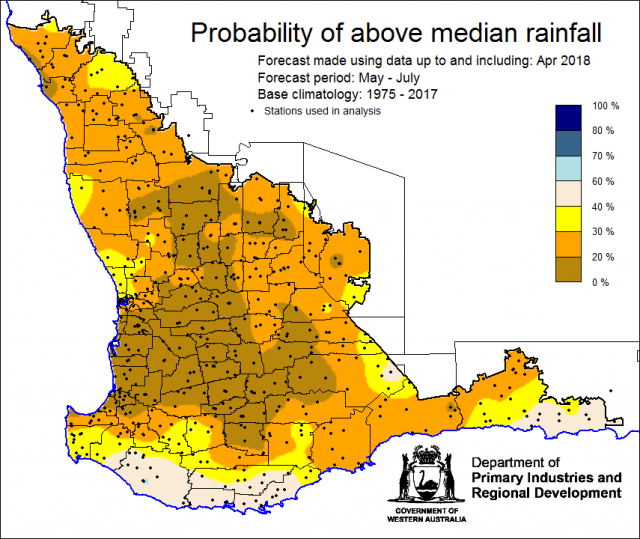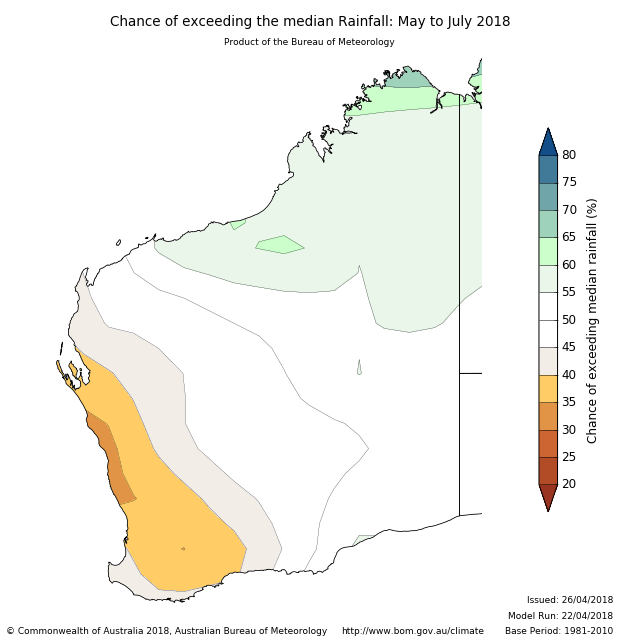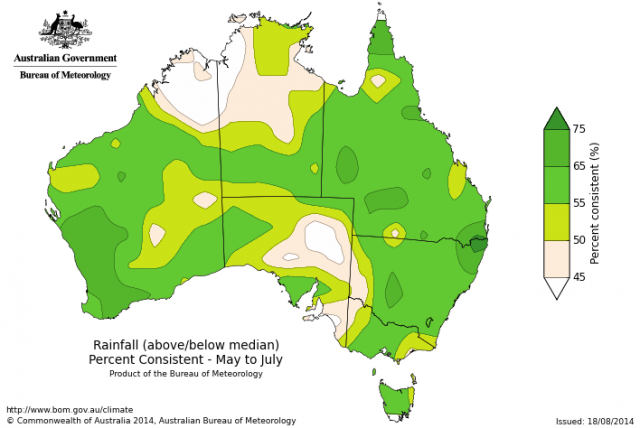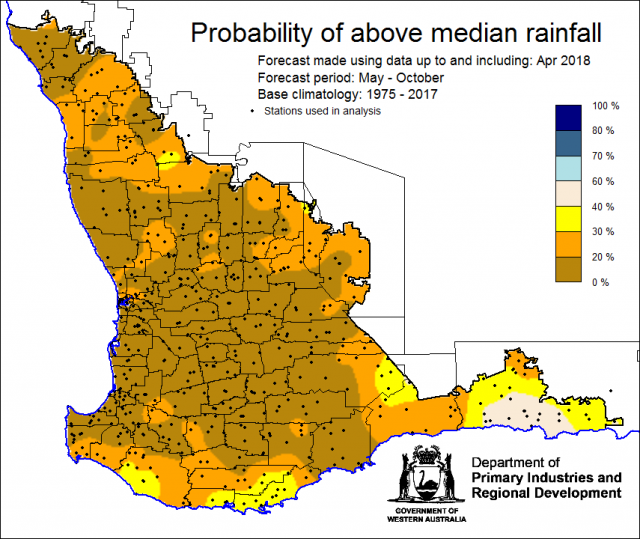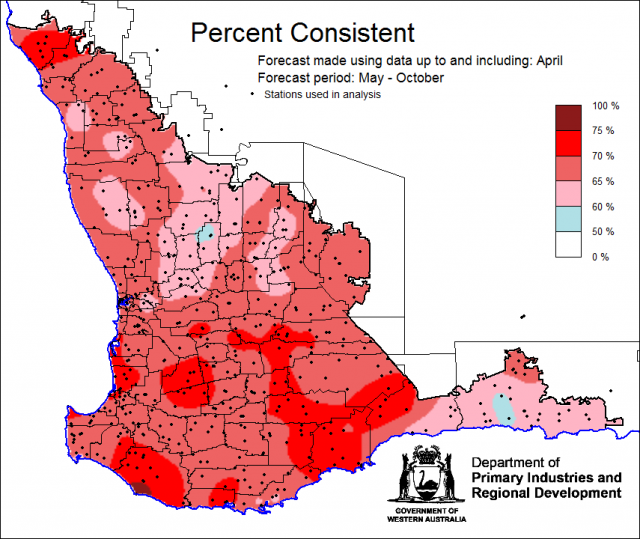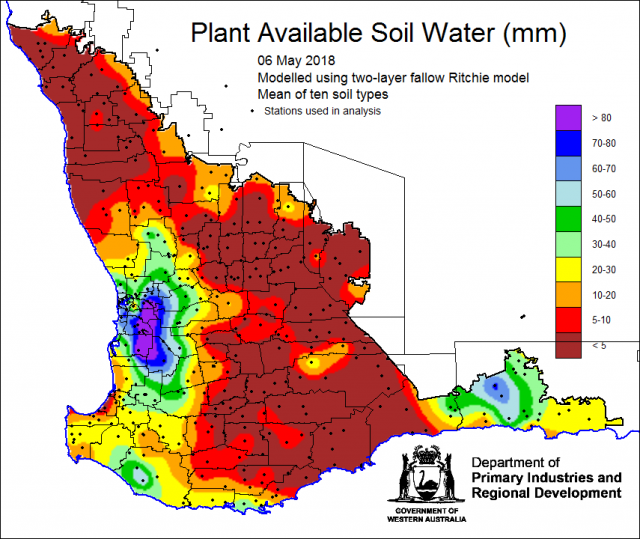Summary
The Department of Primary Industries and Regional Development’s (DPIRD) Statistical Seasonal Forecast (SSF) system is indicating less than 40% chance of exceeding median rainfall for May-July and May-October 2018.
- The SSF is indicating less than 40% chance of exceeding median rainfall for the grainbelt for May to July 2018. The most probable decile range is decile 2-3 for most of the grainbelt. Predictive skill based on April conditions is mostly medium to good (60-75% consistent). In operational use since 2012, SSF has had a high success rate indicating May-July rainfall deviation across the northern and central grainbelt. The model has been less successful for the southern grainbelt and Esperance region for these three months.
- The Bureau of Meteorology’s current seasonal outlook also indicates below normal rain being more likely, showing generally a 30-45% chance of exceeding median rainfall for May-July for the South West Land Division (SWLD). Predictive skill is mostly moderate to good (55-75% consistent).
- Temperature outlooks for May-July 2018 from the Bureau indicate a 60-70% chance of above normal day-time maxima for the SWLD. Skill is moderate to good at 55-75% consistent. Minimum temperature outlooks indicate a 50-65% chance of above normal night-time minima for the SWLD, with skill poor to moderate at 50-65% consistent.
- For May-October, the SSF is also indicating less than a 40% chance of exceeding median rainfall for most of the grainbelt. As for May-July, the most probable decile range is decile 2-3 for most of the grainbelt. Predictive skill is mostly moderate to good, 60-75% consistent. Since 2012 when SSF was developed, the May-October outlook has been correct in five out of six years for the northern and central grainbelt, two out of six years in the southern region and four out of six years in the Esperance region.
- April rainfall in the SWLD was generally below average. April maximum and minimum temperatures were average to above average.
- Current conditions are dry. Despite having summer rainfall there is little plant available soil water in most areas. It appears likely May rainfall will be below average as well. Approximately half of Australian and international climate models are indicating May-July rainfall is likely to be lower than the long term median.
Three month outlook for the south-west of Western Australia
Statistical Seasonal Forecasting (SSF)
DPIRD’s Statistical Seasonal Forecast (SSF) system uses historical relationships between global sea surface temperature and sea level pressure with rainfall in south-west Australia to produce forecasts of rainfall for the coming months. Users can click on any station indicated on the map for location-specific forecast information from the Seasonal Climate Information page.
For May-July, the SSF is indicating less than 40% chance of exceeding median rainfall for the grainbelt, with large parts having less than a 30% chance. The most probable decile range map indicates decile 2-3 rainfall is most likely for most of the grainbelt. Predictive skill based on April conditions is poor to good (50-75% consistent). Since 2012, SSF has had a 100% success rate in correctly indicating relative May-July rainfall in the northern grainbelt and 83% (five out of six years) in the central grainbelt. For the southern and Esperance regions the success rate is lower at 66% (four out of six years) for these three months.
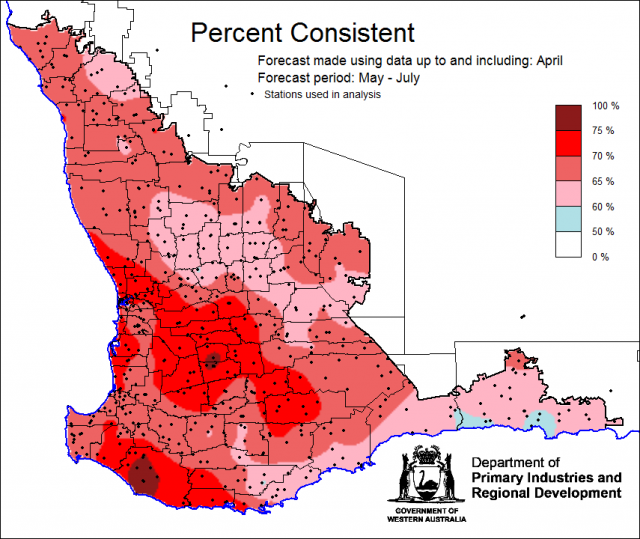
Bureau of Meteorology seasonal climate outlook
The Bureau of Meteorology’s climate outlooks are generated by a dynamical (physics based) coupled atmosphere-ocean climate model.
The Bureau of Meteorology’s current seasonal outlook indicates generally 30-45% chance of exceeding median rainfall for May-July 2018 for most of the SWLD. Predictive skill is mostly moderate to good (55-75% consistent).
Temperature outlooks for May-July 2018 from the Bureau indicate a 60-70% chance of above normal day-time maxima for the SWLD. Skill is moderate to good at 55-75% consistent. Minimum temperature outlooks indicate a 50-65% chance of above normal night-time minima for the SWLD, with skill poor to moderate at 50-65% consistent.
Little rain is predicted for the next 10 days and barring a major event at the end of the month, it appears likely May rainfall will be well below average. A survey of Australian and international climate models indicates half of them are indicating May-July rainfall is likely to be lower than the long-term median.
May to October outlook for South West Land Division
For May-October, the SSF is indicating less than 40% chance of exceeding median rainfall for the grainbelt. The most probable decile rainfall map indicates decile 2-3 most likely for the grainbelt. Predictive skill is poor to good, 50-75% consistent.
A recent Research Updates paper (Guthrie and Evans, 2018) showed that since 2012 (when SSF was developed) the May-October outlook has been correct in five out of six years for the northern and central grainbelt. Two out of six years in the southern region and four out of six years in the Esperance region.
Recent climate
April rainfall was generally below average for the grainbelt. The last three months, February-April rainfall was below average for the northern and southern grainbelt, average for the eastern grainbelt and above average for the Esperance region. April maximum and minimum temperatures were average to above average. Despite the rainfall in late January and early February, there is little plant-available soil water in most areas. The latest modelled plant available soil water map (6 May) shows very low levels of stored soil water in the majority of the grainbelt with good levels in western parts of the Esperance shire.
In April the atmospheric pressure was near normal over the southwest. The Indian Ocean sea surface temperatures north-west and west of Western Australia are also near normal.
In the tropical Pacific, the El Niño–Southern Oscillation (ENSO) remains neutral. All climate models indicate the tropical Pacific Ocean will continue to warm slowly, but temperatures will remain close to average through the southern hemisphere winter. By September, two of the eight models suggest ocean temperatures may approach El Niño thresholds.
The Indian Ocean Dipole (IOD) is currently neutral. Most models indicate a neutral IOD is likely for autumn and early winter. However, three of six models suggest an increased likelihood of a negative IOD developing by July. Typically during negative IOD events, winter–spring rainfall is above average over southern Australia. However, forecast accuracy for the IOD is lower during the autumn compared to other times of the year and should be viewed with some caution. See the Bureau of Meteorology’s IOD and Pacific Ocean interaction for details.
The Southern Annular Mode (SAM), also known as the Antarctic Oscillation (AAO), describes the north–south movement of the westerly wind belt that circles Antarctica, dominating the middle to higher latitudes of the southern hemisphere. SAM is currently near neutral and is expected to remain this way until the end of May.
The table below gives a summary of past month and three month south-west Western Australia (SWWA) climate conditions, and can be used as an indication of what is likely to occur in the near future, if climate conditions follow the current pattern.
| Climate indicator | Past month | Past three months |
|---|---|---|
| SWWA rainfall | Below average | Generally below average |
| SWWA mean temperature | Average to Above average | Above average |
| SWWA atmospheric pressure | Near normal | Near normal |
| Indian Ocean sea surface temperature | Near normal | Cooler |
| El Niño/Southern Oscillation (ENSO) | Neutral | Neutral |
| Indian Ocean Dipole (IOD) | Neutral | Neutral |
| Southern Annular Mode (SAM) | Negative | Positive |

